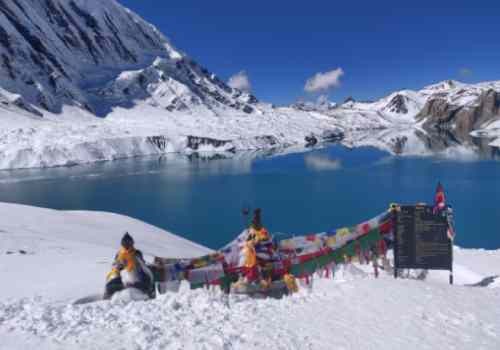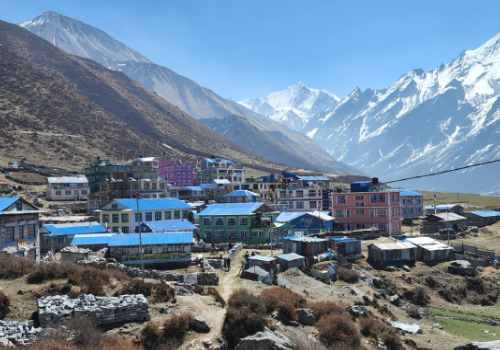If you have an Indian passport, the cost of trekking to Everest Base Camp is INR 100,000. When breaking down the cost, Indian citizens pay slightly less than citizens of other nations because India is a member of the SAARC (Afghanistan, Bangladesh, Bhutan, India, Maldives, Nepal, Pakistan and Sri-Lanka), which lowers the cost of a permit. Additionally, Indian citizens pay less for airline tickets than citizens of other nations, which further lowers the cost of the trip.
People travelling from SAARC countries (Afghanistan, Bangladesh, Bhutan, India, Maldives, Nepal, Pakistan and Sri-Lanka). have low-cost permits, the cost of trekking to Everest Base Camp can be 20 to 50 dollars less for holders of these kinds of Trekkers and travelers coming to Nepal.
EQUIPMENT CHECKLIST
- Duffel/Rucksack bag/Suitcase (We provide one complimentary Trekking Planner duffel bag that is to be returned after the trip)
- Day pack
- Trekking shoes
- Sports shoes or sandals
- Sun Hat/cap
- Warm woolen cap
- Warm fleece jacket or puffy jacket
- Waterproof Gore-Tex layer
- Pullover or warm sweeter
- Raincoat
- 4/5 pairs of good quality socks
- Hand gloves
- 2/3 pairs of trekking trousers
- 3/4 pairs of trekking shirts
- 3/4 pairs of underwear (non cotton preferred)
- Sun glasses
- Water bottle
- 4 season sleeping bag (Optional/we can provide one if you need it. It is to be returned after the trip)
- Flash or Torch light
- Camera and batteries
Best Seasons for Langtang Valley and Gosainkund Trekking:|
Best time in April and May in spring season with September to early December months during autumn and pre-winter times.
April and May with much longer sunlight hours, makes the trek more interesting and very special with wild flowers in season especially the rhododendron of various different species from trees to bush, which is also national flower of Nepal.
Most days are clear from morning till late afternoon, can get cloudy sometimes with chance of snows around higher elevation cold in the morning and night time (without wind-chill factors).
September to December during autumn / fall and pre-winter season most days are crystal clear from morning till mid-afternoon, days are shorter and as well with sunlight hours, much cold with freezing temperatures in the morning and night as well in shades above 1,800 m high (not adding extra wind-chill factor).
Local Culture and Religion:
Langtang Valley within Rasuwa district dominated by Tamang tribe closely linked to Tibetan with similar culture and way of farm and cattle herding traditional life, follows both Buddhism religion and Bon sect of pre-Buddhism an ancient worships of natural surroundings and mountain spirits.
From Gosainkund onward entering into Helambu area populated by both Tamang, Hyalmo with Sherpa of all Buddhism religion with almost similar culture and custom, where every houses festooned with colorful prayer flags which you notice on this wonderful treks and respecting local immense culture of Buddhism religion.
Climate and Weather:
Himalayan climate can be unpredictable sometimes even in good best seasons, where April and May to first week of June will be the best time during spring times, when days are longer with enough sunlight hours.
Morning and night time as well in shade can be cold and much freezing temperatures around higher areas above 3,000 m.
Other months from September to November another great times for treks around Himalaya, when days are clear for views, although much colder months of autumn season with extreme cold during morning and night time, where sunlight is much shorter.
Visa:
Visiting Nepal one can obtain entry visa from your home country at Nepalese Embassies and Consulates, if not one can easily get visa on arrival at Nepal international airport in Kathmandu, or any port of entry.
Emergency Contact:
For travel within Nepal Himalaya where all travelers and adventurer requires to fill our company form with emergency contact to relatives and families or close friends, as well keeping in close touch with Trekking Planner for immediate helps either medical or unforeseen reasons.
Arrival:
On arrival picked and received by our attentive airport representative or guides and staff for short transfer to your respective hotels in Kathmandu.
Accommodations & Food:
On Langtang & Gosainkund Trekking staying on best available local lodge from the start to and end of treks with nice meals as per your choice from wide range listed menu from the lodge serving from famous Nepalese Dal-Bhat to Continental with some Chinese, Tibetans and Indian foods.
All meals are well cooked, hygienic and fresh served in a large dining hall with warm environment.
Drinking Water:
On local lodge safe drinking water boiled and filtered for drinking.
Health:
Where all travelers require sound good health to join on all treks and climbs around Nepal Himalaya with healthy medical background and history.
Vaccinations:
Check with your home doctors and season of visit to Asian countries where immunization and vaccines requires against certain disease.
Altitude Sickness:
Altitude Sickness of AMS (Acute Mountain Sickness) might occur to some people on higher altitude from 2,000 m for some above 3,000 m high where taking slow and drinking much fluid and water can overcome from high altitude sickness or AMS.
On this trek AMS does not occur as you will be well acclimatized slowly on daily walks and with overnight stops at certain heights.
Where some can take protective measures using Diamox or Acetazolamide tablets this prevent and reduce symptoms of AMS can lower headache in high altitude walks and climb.
People with severe cases and situation of HACE and HAPE where victim will be brought down to safe and secure places with medical team or doctors to attend, the fastest means is emergency evacuation by any means of immediate and fast transportation where available.
Around Nepal Himalaya the quickest emergency evacuation by means of Helicopter services to bring the victims back to Kathmandu and for further treatments.
For emergency evacuation where trekkers should be well insured with good Insurance policy that covers all medical side and the use of Helicopter or other means of transportation.
Travel Insurance:
Where all travelers to Nepal Himalaya require Travel and Medical Insurance to cover against unfortunate accidents and sickness covering Helicopter Service Rescue to safe places and nearest hospitals.
Age Requirements:
On this trek to Langtang and Gosainkund Trekking suitable for all age interested people from teens to elderly age of 70 years will be allowed if one can get medical insurance from your home countries.
TIMS Card
TIMS (Trekking Information Management Systems) or similar permits for this treks includes Langtang National Park entrance fee as well.
Getting Into Nepal:
To reach Nepal one can reach by overland from India or Tibet, the main arrival from international flight to reach Kathmandu and Nepal international airport.
Communication:
At present nearly all villages and towns do have facilities of ISTD and STD or cell phones or Sat phones, where one can easily communicate to your family or Trekking Planner in emergency situations.
SIMS cards available on showing your passport copies with small charge as per your time in Nepal.
Money:
On paying full package of the trip, where you need some extra money for your own individual expenses to buy souvenirs or for extra entertainment on route treks like having extra snacks and drinks.
Culture:
Culture the main thing to observe by travelers to Nepal, where the country with two main religions Hindu and Buddhism with their own special interesting culture and custom.
Photography:
Photography can be taken all around Nepal, where some public and private areas of Government, religious monuments and some old people might not allow photographs, where your guide will advise you on restricted places.
Gratuities:
Tipping after getting satisfied with the service rendered by helpful staff of the hotels, drivers including guides and porters where you feel like it deserves gratitude like tipping.
Tipping is highly expected by crew members of trekking and on expeditions as traditions since tourism came in Himalayan countries.
.jpg)


